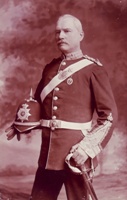
Photograph of Edward in Tameside Local Studies and Archives Centre. Reference: Acc.3318

Volunteer Decoration
Edward was born on the 3rd July 1838 in Corwen, in Merionethshire, North Wales. He was named after his father, who worked as a maltster.
By mid 1859 Edward had moved to Manchester, Lancashire. At this time tensions between Britain and France were very high, and many in Britain feared that a war would break out. The French Army was far larger than the British Army, and this led many people to fear that if Britain were invaded, the Army might not be able to stop the French. In order to help reinforce the Army, Lieutenants of Counties were encouraged to raise Volunteer Rifle Corps that could help defend their local area.
In Manchester 2 Regiments of Rifle Volunteers had been formed by December. A 3rd Regiment was then formed, and Number 1 Company of this was raised by Alexander Henry of A & S Henry and Company, a cotton distribution firm. Edward was one of the original members of this Company, joining it in 1859, which suggests that he worked for A & S Henry. The 3rd Regiment soon became known as the 40th Lancashire Rifle Volunteer Corps (LRVC).
Volunteers kept their homes and civilian jobs. They trained during evenings and weekends, and later they began to hold an annual camp. At first the Volunteers had to purchase their own uniforms and rifles, and the units received very little funding from the Army.
Edward served in the ranks of Number 1 Company for 20 years. He was commissioned as a Second Lieutenant in the 40th LRVC on the 16th August 1879, and became a Lieutenant on the 28th August of the next year. Shortly after this the unit's name was changed to the 16th LRVC.
As well as his military career, Edward had started a family. He married Elizabeth Varey Sutton on the 12th June 1862 at St John's Church in Manchester. Robert Sutton, her father, was a spindle maker in Manchester. Their first child, Elizabeth Varey Sutton Pierce was born on the 21st June 1863. Their second child, Arthur Harry was born on the 21rd April 1867 and Maud Amy Edith was born on the 23rd April 1869. Horatio Garnet was born on the 14th February 1874 and Frank Reginald Leopold on the 4th Sept 1876. There were two other sons who died in infancy.
The family made their home in Heaton Norris near Stockport, which was then in Cheshire. In 1881 they lived at 3 Peel Moat Road. Edward was a warehouseman. Ten years later they had moved to 32 Tatton Road South in Heaton Norris. Edward had been promoted; he was now a departmental manager at his warehouse.
Edward continued to serve in the 16th LRVC. He went with them on almost all of their annual training camps, which began in the early 1880s. These were held in rural areas and allowed the battalion to train together for an extended period of time, usually around 2 weeks, and to practice larger and more complicated manoeuvres.
Over the course of Edward's time as a Volunteer, the movement had been slowly but surely brought under tighter control by the Army. They began to assign Regular soldiers to Volunteer units as permanent training staff, and took more responsibility for providing rifles and ammunition. When the Regiments of the Regular Army were given territorial names and recruiting areas in 1881 it was decided to rename the Volunteer units in these areas to match. This meant that the 16th LRVC became the 4th Volunteer Battalion of the Manchester Regiment.
Edward was promoted to Captain on the 6th December 1890. He became an Honorary Major on the 10th January 1891. In 1892 the Army introduced a medal to recognise long-serving Volunteer officers. This was the Volunteer Decoration, and Edward was one of the first officers to receive it.
In 1900 an officer of the 4th Volunteer Battalion wrote a book titled 'Records of the 4th Volunteer Battalion Manchester Regiment'. In the section describing the formation of the unit in 1859 Edward was the only person named as 'one of the original members'. This suggests he may have been the only one still serving. He finally retired on the 23rd November 1901, after 42 years.
In April 1901 Edward and Elizabeth lived at 'Moelcrest', 2 Ellesmere Road in Heaton Norris. He had not retired from his civilian job, and was still a departmental manager. Edward died on the 20th October 1902. He was 64 years old.
In 1911 his widow, Elizabeth, lived with her widowed daughter Maude Amy Edith Cadman and her granddaughter Dorothy Gwendoline at 21 Brown Edge Lane in Fairfield, Buxton, Derbyshire. She died in this area aged 80 on the 4th October 1921.
Horatio followed his father into the 4th Volunteer Battalion. He was given the service number 4994 and had reached the rank of Sergeant by 1900. He spent some time in the Mounted Infantry Company of the battalion and in January 1900 he volunteered to fight in the Boer War in South Africa as a member of the Imperial Yeomanry. He died on the 4th July 1943 aged 69. His brother Arthur worked for A & S Henry and Co and Frank worked for a railway company in London.
The medals of both Edward and Horatio were donated to the Museum of the Manchester Regiment in November 1996.




